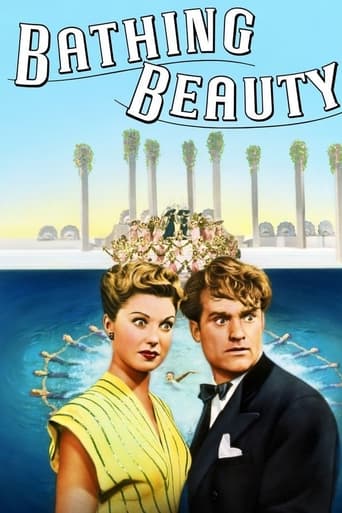

The swimming routines of Esther Williams and the comedy of Red Skelton are timeless which is why Esther's debut as a star can be seen hundreds of years from now and not lose any entertainment value. Of course an appreciation of swing music and Latin music does help.Bathing Beauty which is certainly an appropriate title for Esther's first starring role has Red and Esther as newly minted newlyweds when some woman objects to the wedding saying she's already Red's wife.Red's a writer of swing music and his publisher Basil Rathbone deliberately arranged that incident to break up the marriage so Red can deliver some special material. However the minister beat out the objection with his 'I now pronounce you man and wife' so they are married, but Esther will get that annulled. But not if Red can help it. She goes back to her old job teaching at an all girl's college which Red enrolls at as a student to be near her to plead his case. At this point the rather thin plot is just a frame for the various routines and numbers done by the stars and with guest performers like Harry James and his Orchestra, Xavier Cugat and his Orchestra and the famous Tico Tico girl Ethel Smith doing, what else Tico Tico on the organ. Also orchestra vocalists Helen Forrest with James and Lina Romay with Cugat have some good numbers.Basil Rathbone taking time off from playing Sherlock Holmes hams it up to beat both those featured bands in his role as the comic villain of the piece. Red does his usual clowning and is an adept musical performer in a swing version of Loch Lomond.But this film is strictly Esther and her final water ballet sequence was the first of many making use of that special tank MGM built for this very special star.You could remake this film today, but where would you ever come up with another Esther Williams or Red Skelton?
... View MoreBATHING BEAUTY was never meant to be a classic. It's primarily an excuse to feature Red Skelton in some of his "routiens", like being in drag and doing lots of pantomime. Also a vehicle for showcasing Esther Williams who was just starting out in films. She does well for her first co-starring role. Red is the star in this one unlike NEPTUNES DAUGHTER where he co-stars. The film is likable enough and fun to watch for the by-gone days of the flimsy MGM musical that it is. The plot is almost non-existent and again, just an excuse for Reds antics. Look for a young Janis Paige in the best number in the film. BATHING BEAUTY is one of six titles on DVD in the Williams collection. Now if Warner's would just put out another collection which should include some her better material i.e. EASY TO LOVE; DUCHESS OF IDAHO; SKIRTS AHOY; MILLION DOLLAR MERMAID and THRILL OF A ROMANCE.
... View MoreBathing Beauty is one of those films that one can see over and over again. Lavishly produced and with a wonderful and exciting music, it is a picture that must be included in every DVD collection. My first contact with this movie was one late night when I taped it from our local TV station. Then, several years later, my daughter Paloma was only 10 when she saw it for the first time. She was fascinated!! Now she is 18 and knows the music and most of the script by heart. Esther Williams is beautiful, very warm and excellent swimmer. Skelton funny as always. Although the plot is silly, it serves as a frame for a wonderful presentation of long past artists such as our Colombian Carlos Julio Ramírez who was considered one of our best baritones. Also, Xavier Cugat "Cugie", Harry James and Ethel Smith. Today we have no artists like them. So if you enjoy MGM musicals, you will enjoy this one quite a lot!!
... View MoreBATHING BEAUTY offers lots of eye candy and a couple of hilarious RED SKELTON routines proving he's a master at physical comedy. The musical interludes are on the dull side and don't give strong enough material to Ethel Smith (at the organ), Harry James, Xavier Cugat and Carlos Ramirez--a Latin tenor with a strong voice but no charisma.The slender plot is the usual misunderstanding that occurs in these type of ESTHER WILLIAMS movies. She thinks her newly wed hubby (Red) is the father of three boys, thanks to a practical joke played by BASIL RATHBONE (who looks as if he'd rather be elsewhere in a thankless role). She tries throughout the film to get Red dismissed from the all girl college he enters just to be near her. The highlight of the film is Red's bashful entrance into a class of ballerinas, clad in pink tutu and ballet slippers--all the while being slapped around by a ruthless instructor and going through ballet paces with hilarious results.The supporting cast is largely wasted--including Bill Goodwin, Margaret Dumont and Janis Paige in a brief role. Jean Porter gets to do more than usual and even has a song and dance number with Red. The water ballet at the finale is nicely done in typical MGM manner but not as ostentatious as usual for an Esther Williams film. This was her debut as a leading lady and she has lots of confidence and poise, both in and out of the water. In fact, it's one of her better performances--but the spotlight belongs to Red Skelton who deserves his top billing.
... View More